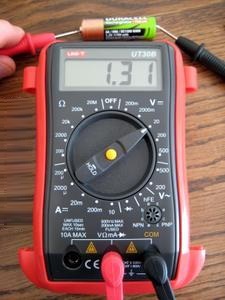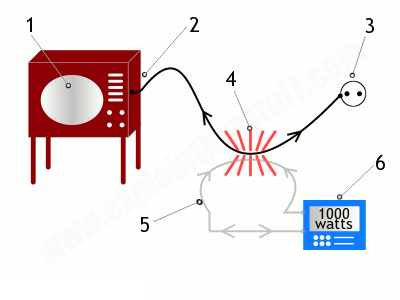We can measure electricity in a number of different ways, but a few measurements are particularly important.
Photo: You can use a digital multimeter like this to measure voltage, current, and resistance.

Voltage
The voltage is a kind of electrical force that makes electricity move through a wire and we measure it in volts. The bigger the voltage, the more current will tend to flow. So a 12-volt car battery will generally produce more current than a 1.5-volt flashlight battery.
Current
Voltage does not, itself, go anywhere: it’s quite wrong to talk about voltage “flowing through” things. What moves through the wire in a circuit is electrical current: a steady flow of electrons, measured in amperes (or amps).
Power
Together, voltage and current give you electrical power. The bigger the voltage and the bigger the current, the more electrical power you have. We measure electric power in units called watts. Something that uses 1 watt uses 1 joule of energy each second.
The electric power in a circuit is equal to the voltage × the current (in other words: watts = volts × amps). So if you have a 100-watt (100 W) light and you know your electricity supply is rated as 120 volts (typical household voltage in the United States), the current flowing must be 100/120 = 0.8 amps. If you’re in Europe, your household voltage is more likely 230 volts. So if you use the same 100-watt light, the current flowing is 100/230 = 0.4 amps. The light burns just as brightly in both countries and uses the same amount of power in each case; in Europe, it uses a higher voltage and lowers current; in the States, there’s a lower voltage and higher current. (One quick note: 120 volts and 230 volts are the “nominal” or standard household voltages—the voltages you’re supposed to have, in theory. In practice, your home might have more or less voltage than this, for all sorts of reasons, but mainly because of how far you are from your local power plant or power supply.)
Energy
Power is a measurement of how much energy you’re using each second. To find out the total amount of energy an electric appliance uses, you have to multiply the power it uses per second by the total number of seconds you use it for. The result you get is measured in units of power × time, often converted into a standard unit called the kilowatt-hour (kWh). If you used an electric toaster rated at 1000 watts (1 kilowatt) for a whole hour, you’d use the 1-kilowatt-hour of energy; you’d use the same amount of energy burning a 2000 watt toaster for 0.5 hours or a 100-watt lamp for 10 hours. See how it works?
Electricity meters (like the one shown in the photo above, from my house) show the total number of kilowatt hours of electricity you’ve used. The 1-kilowatt-hour is equal to 3.6 million joules (J) of energy (or 3.6 megajoules if you prefer).
You can measure your energy consumption automatically with an energy monitor.
How energy monitors work

1. You switch on your appliance.
2. Alternating current (AC) carries electrical energy into it.
3. The AC current flows back and forth along the power cable between the power outlet and your appliance.
4. As the current changes, it creates a magnetic field all around the cable.
5. Put your energy monitor’s probe near the cable and the magnetic field causes a secondary alternating current to flow inside it. (The magnetic field from an ordinary household cable is weak so the probe will need to be very close to the cable. With some energy monitors, such as the Wattson, the sensor/probe clamps tightly around one of the power cables near your fuse box.)
6. Your energy monitor measures the size of this secondary current and either convert it into a measurement in watts (W) or calculates the running cost per hour.